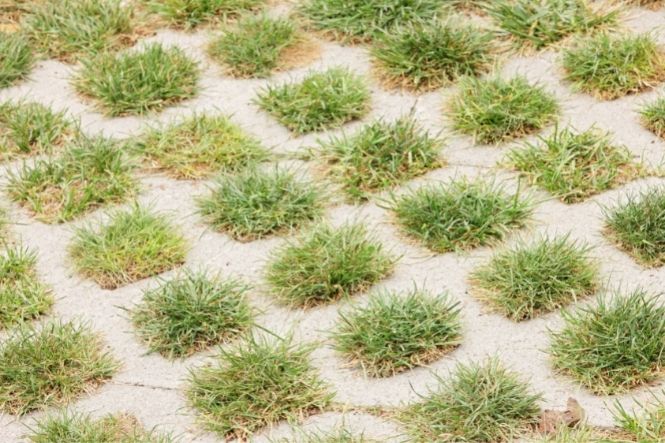With the increasing focus on ecology and green issues, even the humble domestic drive has been singled out for attack. Studies have shown that paving over such a large proportion of urban front gardens is causing problems with flooding, as well as destroying habitats for insects, birds and other small animals.
Green Grass Solutions
So it’s not really surprising that paving solutions to tackle this problem are coming onto the market, although some of them have been around for many years. One of the biggest areas of growth is in cellular paving systems, such as grasscrete, where grass or other material is placed in the gaps (or cells) of a mesh. The mesh can be made of a variety of materials – grasscrete, as the name suggests, is a concrete block mesh. Cellular paving is such a big area that it is covered in a separate article in this section (see Cellular Paving Systems For Your Driveway.)
Other solutions fall into two categories: planting patterns with ordinary paving blocks that allow grass to grow through, and grass reinforcement systems. With both of these it’s important to note that the grass chosen for the project needs to be hardy enough to withstand being driven over. The best thing to do is to take the advice of the manufacturer of the system you are going to use.
Block Laying Patterns for Grassy Oases
Laying patterns that allow some oases for plants are a good idea. Rain can go down into the gaps and drain away through the bedding layer and sub-base into the water table, rather than running straight off into the drains. This is contributing, if in a minor way, to the flooding problems in the UK in recent years (see Environmental Issues When Constructing A Driveway on this site). The gaps can be filled with gravel, or other aggregate, if a partially turfed look is not what you are looking for.
One popular method is known as ‘hopsack’, after the pattern it follows. It’s a simple pattern and can be laid with any commercially available block or slab as long as it’s rectangular. With hopsack the coverage of the drive area will be something like 75% paved and the rest clear, so there’s a solid enough surface for cars and a place for grass, too.
Spaced Paving
Almost any other block laying pattern can also be used with spacers to keep the blocks further apart than normal, then plants can grow in these widened gaps. This technique is known as ‘spaced paving’. The spacers are usually proprietary ones from the same manufacturer as the blocks or slabs, so widths vary but they are usually between three to five centimetres. Of course, you could simply leave gaps but that’s likely to give structural problems, and using spacers keeps the gaps consistent so the drive still looks good.
With both hopsack and spaced paving, the bedding layer will have to be of grit, or a grit and sand mix, to allow drainage into the sub-base. Although the holes can be filled with soil (which should be friable) immediately after laying the blocks, it’s worth waiting for a month or so for it to settle, before topping up then seeding.
Grass Reinforcement Systems
With grass reinforcement there are two main systems: reinforced turf, and mesh protected turf, popular for temporary driveways. Reinforced turf uses geo-membranes, on which the grass is grown, which are then applied over a bedding layer and sub-base. The resulting surface can then be mowed and cared for just like a normal lawn but take cars as well. This turf should last up to 10 years.
Mesh protected turf sounds like cellular paving under another name, but it differs in that the mesh, made from tough plastic and usually green, is simply laid over an existing grass surface. It is pegged down and grass can then grow through the mesh, and again it can be mowed and cared for like a normal lawn.
This will not protect the grass completely, and doesn’t provide a hardened surface for heavy vehicle use, but the idea is that it stops the grass being completely ruined and helps cars travel over the surface as long as it’s not too rutted or hilly. For temporary events, like overspill parking at schools or sports fields, it can be taken up afterwards or left in place for the next event.

